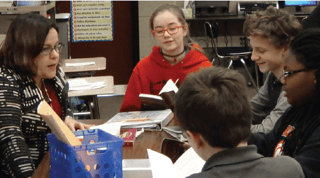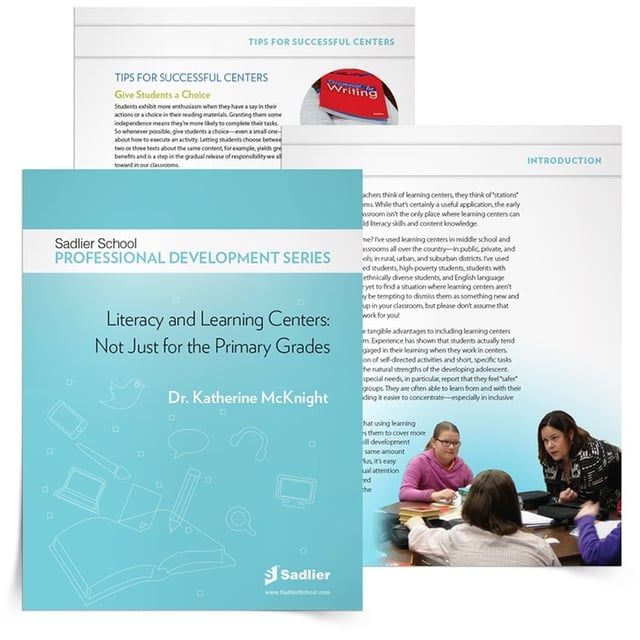April 11, 2016 CL Teaching Strategies Pro Reads, ELA PD - Literacy, ELA K-5, ELA Focus - Reading, ELA 6-8, ELA Resources - Tip Sheets, ELA Focus - Writing, Core Literacy
Learning and Literacy Centers: An Effective Instructional Model for Meeting the Needs of All Students
By: Guest Blogger
Today I'm excited to have Dr. Katherine McKnight sharing her expertise on implementing Literacy Centers into classroom instruction. Give my guest blogger a warm welcome!
When most teachers think of literacy and learning centers (LLC), they think of “stations” in K–3 classrooms. While that’s certainly a useful application, the early elementary classroom isn’t the only place learning and literacy centers can be used to build literacy skills and content knowledge.
 Don’t believe me? I’ve used learning and literacy centers in middle school and high school classrooms all over the country – in public, private, and parochial schools; in rural, urban, and suburban districts. I’ve used them with gifted students, high-poverty students, students with special needs, ethnically diverse students, and English language learners. I have yet to find a situation where learning centers aren’t effective. What is particularly exciting about centers is that this model is conducive to all kinds of classrooms.
Don’t believe me? I’ve used learning and literacy centers in middle school and high school classrooms all over the country – in public, private, and parochial schools; in rural, urban, and suburban districts. I’ve used them with gifted students, high-poverty students, students with special needs, ethnically diverse students, and English language learners. I have yet to find a situation where learning centers aren’t effective. What is particularly exciting about centers is that this model is conducive to all kinds of classrooms.
There are some tangible advantages to including learning and literacy centers in the classroom. Experience has shown that students actually tend to be more engaged when they work in centers. The combination of self-directed activity and short, specific task lends itself to the natural strengths of the developing adolescent. Students with special needs, in particular, report that they feel “safer” in these small groups. They are often able to learn from and with their peers while finding it easier to concentrate – especially in inclusive classrooms.
Teachers find that learning and literacy centers enable them to cover more content and skill development in the same amount of class time. Plus, it’s easy to give individual attention and personalized instruction to students who need it.
As you consider the benefits of centers for your classroom as an instructional strategy that leads to greater student achievement and development of literacy skills, consider three phases to get started that can provide a road map for implementation. I also provided the research to support each of the LLC implementation phases.
Phase 1
Goal: Change Physical Environment in the Classroom
Create physical environments that are conducive to student collaboration and discussion. Including:
-
Seating arrangements that support flexible grouping. (Advancing Differentiation: Thinking and Learning for the 21st Century by Richard Cash; Making Differentiation a Habit by Diane Heacox)
-
Purposeful movement that reflects current research in brain-based learning. (Teaching with the Brain in Mind by Eric Jensen; Boys and Girls Learn Differently by Michael Gurian; Brain Rules by Jon Medina)
-
Chunking of instruction that supports current research in adolescent learning. (Teaching with Poverty in Mind by Eric Jensen, Boys and Girls Learn Differently by Michael Gurian; Brain Rules by Jon Medina, The Art and Science of Teaching by Robert Marzano; The Highly Engaged Classroom by Robert Marzano)
-
Written, explicit directions that encourage student ability to self regulate their learning. (Visible Learning, What Works Best for Learning by Jon Hattie, Advancing Differentiation: Thinking and Learning for the 21st Century by Richard Cash)
In this phase, focus on the physical aspects that foster student centered instruction: transitions, collaborative norms for expectations, student roles, and timing of activities.
Phase 2
Goal: Increase Cognitive Load
(Marzano’s Taxonomy of Cognitive Levels, Bloom's Taxonomy of Educational Objectives for Skills-Based Goals, Visible Learning, What Works Best for Learning by Jon Hattie)
Implement centers 1-2 times a week, adapting current lessons to meet the center framework and guidelines. (Marzano’s Taxonomy of Cognitive Levels, Bloom's Taxonomy of Educational Objectives for Skills-Based Goals, Visible Learning, What Works Best for Learning by Jon Hattie)
-
Provide collaborative, center activities that develop higher order thinking skills and the application of literacy skills and content knowledge.
Phase 3
Goal: Assessment and Feedback
Ensure that these centers are incorporated 2-3 times a week and all activities require students to apply literacy skills and content knowledge.
-
Provide formative assessment opportunities to adjust and enhance instruction that develops student learning (e.g., observational, checks for understanding, descriptive feedback) (Formative Assessment and Standards Based Grading by Robert Marzano; Fair isn’t Always Equal by Rick Wormeli)
-
Offer Multi-Tiered Intervention to address:
a. gaps in learning
b. knowledge and skills that students need to be successful in Tier I. (Response to Intervention & How to Respond When Kids Don’t Learn by Austin Buffman and Mike Mattos)
-
Create activities that are designed to promote mastery of literacy skills and content knowledge.
-
Provide descriptive feedback to foster student skill development mastery and content knowledge. (Formative Assessment and Standards Based Grading by Robert Marzano)
-
Include the Teacher-led center to address individual learning needs (i.e., interventions, differentiation, enrichment, formative assessment, and targeted skill development).
There is much to consider for learning and literacy center implementation but the rewards are rich. Imagine the impact on closing the achievement gap of all students and fostering a classroom that is happy and engaging. Download my Literacy and Learning Centers eBook and get started today! Please let me know how you are progressing.
| Dr. McKnight is an author, educator and consultant. Her career in education began as a high school English teacher in the Chicago Public School system more than 25 years ago. She received her B.A. degree from George Washington University, her M.Ed. from Northeastern Illinois University, and her Ph.D. from the University of Illinois at Chicago. She currently serves as a Distinguished Professor of Research at National Louis University. She travels worldwide as a professional development consultant and a sought after speaker in the fields of adolescent literacy, inclusive classrooms, Common Core State Standards, Interdisciplinary literacy, and integrating technology in the 21st century classroom. |




